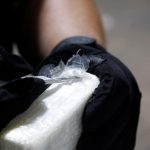US has channelled millions to clean up UXO but farmers and children continue to discover unexploded missiles.
Quang Tri Province, Vietnam – Ho Sy Bay, 62, was rummaging around in his garden in central Vietnam when he struck something harder than sand or soil. Cautiously, he brushed aside the surrounding dirt and realised he was staring at an unexploded missile.
Although Sy was unsure if the fuse was still intact, he picked up the bomb and placed it carefully in a thicket on one side of his vegetable patch.
“I found it last Thursday,” Sy told Al Jazeera on a visit to his home in Quang Tri province, adding that he informed local officials right away. “Sometimes I find other objects as well. After the war, I started working as a scrap collector and found many types of explosives. Back in 1975, when I was 20, I would find bigger explosives with metal detectors and sell them.”
Behind Sy’s house lie the shattered ruins of a church where North Vietnamese Army soldiers used to hide during the Vietnam War, making the building a target for successive bombing raids by the United States military, which backed the South Vietnamese government in what was then known as Saigon and is now Ho Chi Minh City.
“Around 1979, I found a body around here,” he said, pointing to an area of his garden where he found the remains of a Vietnamese soldier, which was taken away by the authorities.
The US carried out more than a million bombing raids during the 20-year conflict, dropping some 5 million tonnes of ordnance on the Southeast Asian country. About a third of the munitions, including cluster bombs, did not explode on impact.
It has now been more than 50 years since the last US soldier left Vietnam – on March 29, 1973 – but tens of thousands of explosives are still being found each year, often mere inches beneath the soil.
‘Reality of war’
In Quang Tri province, which was once divided by the demilitarised zone between North and South Vietnam and remains the most heavily-contaminated province in the country, there have been 3,500 deaths from accidents since the war ended. The last death was in 2022, when a bomb exploded in a farmer’s hands after he discovered it in a field and picked it up.
“After seeing so many accidents and doing scrap collecting work for a long time, I stopped,” Sy added. Yet despite his experiences, he is not angry: “I feel like everyone else… this is just the reality of war.”
The Mines Advisory Group (MAG), a United Kingdom-based NGO that has been working in Vietnam since 1999 and now employs 735 people in the country, came to remove the bomb in Sy’s garden after he called a local hotline.Every day, MAG’s staff scour the landscape with metal detectors, searching for unexploded ordnance (UXO) to clear so the land can be made safe and ready for agriculture or development. In 2022, MAG destroyed 14,615 bombs, clearing just more than 10 square kilometres (3.86 sq miles) of land.
In the nearby Xuan Vien village, a group of local children aged between eight and 12 were playing near a muddy ditch when they came across an unusual-looking object.
Tran Duy Vinh, the village head, told Al Jazeera the children had finished playing football and thought they might catch some fish instead.
“They found an explosive, picked it up, and passed it around,” Vinh said. “They didn’t know what it was and started to play with it.”
Vinh immediately called the government-run hotline, which allows local authorities to ask organisations like MAG, as well as the Vietnamese military, to clear UXO. “Everyone around here has the number,” he said.
Dinh Ngoc Vu, the vice director of the government-run Quang Tri Mine Action Centre (QTMAC), which operates the hotline, said: “I think this work has helped to heal the wounds of the war – from both perspectives.”
Between 1993 and 2020, the US invested more than $166m into programmes in Vietnam focusing on war legacy issues such as clearing mines and UXO and providing explosive ordnance risk education.
During an official visit to Vietnam in April, US Secretary of State Antony Blinken said Washington was committed to addressing the legacies of the war.
“Even as we focus on the future…. We’re continuing our joint efforts to clear unexploded ordnance – next month, we will complete the survey of the heavily bombed Quang Tri Province,” he told reporters.
International NGOs and the Vietnamese military have already cleared UXO from 173 sq km (67 sq miles) of land. QTMAC estimates that it will take 13 more years to clear the province of explosives.
“And we are continuing the important humanitarian work to account for those missing from the war – including by increasing Vietnam’s capacity to identify its own missing and dead,” he added.
Work that saves lives
By the end of the Vietnam War, there was not a single province that was not contaminated with UXO. Nationwide, there have been more than 100,000 deaths and injuries in the past 50 years, according to Sarah Goring, MAG’s Vietnam Country Director.
After finding unexploded bombs, MAG staff either destroy them where they were found or take the ordnance away to a demolition site to be safely destroyed.
Ta Quang Hung, MAG’s technical field manager, has worked for the organisation since 1999. Previously, he worked as a farmer in a rural area that was heavily contaminated with UXO.
“I grew up in an area with a heavy presence of unexploded ordnance. I would step out of my house and be faced with them,” he told Al Jazeera.
As a child, Hung found explosives and played with them, without knowing what they were. Hung and his friends would throw small explosives at a wall or a target, competing to see who could hit it first. Thankfully, adults caught them and halted their perilous games.
But not everyone was so lucky.
He recalls another memory, from the mid-1970s, when two of his relatives, women who had married into his family, were working in the fields together.
“We were evacuated during the war, but after the liberation, we went back to work in our fields right away,” he said. “They were together when they found the explosive. It might have been a 40mm grenade or cluster munitions… Both of them died.”
To mitigate the risk of further tragedies, MAG runs advertisements on social media, inviting villagers to join educational sessions in which participants learn about the risks of UXO, play games and chant the hotline number.
Although these lethal artefacts of the Vietnam War still claim lives, the organisations working to clear UXO from the land offer a chance for Vietnamese people not only to take action, but also to come to terms with the past.
Thai Van Ninh, who has worked for MAG since 2015, lost his 12-year-old brother to an unexploded bomb when he was just six years old.
“When I first started, I was scared to work with bombs, having lost my brother to one,” he said. “But after the training… I realised my work saves lives.”


